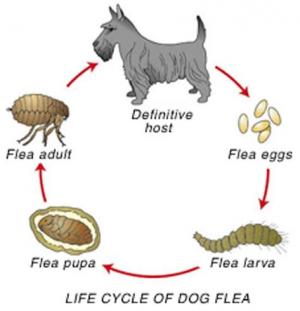Fleas

How can I get rid of the fleas? You have to treat the animal in question, all in-contact animals and the environment. Understanding the life cycle will help to think through the logic of recommended treatments. Consistency is key!
 How does the flea life cycle work?
How does the flea life cycle work?
Eggs (50%): Eggs are ½ mm in length and cannot be seen with naked eye. They are laid on the animal and drop to the ground. High humidity and temperature enable hatching.
Larvae (35%): Larvae are 2-5 mm in length and live deep in carpets and under organic debris outside feeding on the debris and adult flea faeces. Moisture is essential for survival and they will die if it’s too dry. Outdoor larval development occurs in shaded moist areas where pets spend a significant amount of time.
Pupae (10%): Larvae pupate to produce sticky cocoons. Larvae can live in cocoons for up to a year. Alternatively adults can emerge within 5-10 days when stimulated by physical pressure, carbon dioxide or heat all produced by a host.
Adults (5%): Have to eat within days to survive. They start laying eggs 24 hours after first blood meal. They can live for up to 3 weeks and females lay 40 eggs daily.
The entire life cycle can be completed in 14-21 days with optimum temperature and humidity.
How do I know if my pet has fleas?
You can get a good idea from their grooming habits. Excessive scratching and hair loss, especially around the rump and ventral abdominal area are sure signs. Fleas hide around the tail base and behind the ears. Often you can see them running when you lift the tail. You can also stroke the hair from the tail forwards and observe flea dirt (faeces), which looks like grains of black sand. Alternatively you can buy a flea comb which leaves no need for interpretation.
So what must I do?
Treat your Pet: Treat monthly with a product that has a residual action of one month. If you have a massive infestation you need to do this every 2 weeks for the first 2 months.
 Spot on products generally kill the fleas within a 24 hours. That means that if a newly hatched flea jumps on the host it will be killed before it can take a blood meal and lay eggs. Some of these products contain an insect growth regulator which interferes with egg production and the hatching of fleas. It also halts the pupation of the larvae. These products do not repel fleas so you will still notice live fleas on your pet as they succumb to the active ingredient.
Spot on products generally kill the fleas within a 24 hours. That means that if a newly hatched flea jumps on the host it will be killed before it can take a blood meal and lay eggs. Some of these products contain an insect growth regulator which interferes with egg production and the hatching of fleas. It also halts the pupation of the larvae. These products do not repel fleas so you will still notice live fleas on your pet as they succumb to the active ingredient.
Your other option is to give a monthly tablet. Not all oral medications work in the same way. Program renders the flea infertile so they cannot lay viable eggs but do not kill the adult flea outright. These tablets are great for long term control but do not bring an infestation under control immediately. Capstar kills all adult fleas within 20 minutes. This is great in emergency situations but the effect only lasts for 2 days.
Remember the fleas you see on your dog are only 5% of the population present. Continue during the winter months as there are fewer fleas but they are still  laying thousands of eggs ready for the summer explosion.
laying thousands of eggs ready for the summer explosion.
Treat In-contact animals: Cats and dogs share the same flea species. All your pets are a source of fleas even if they don’t seem to have a problem. They may have a greater tolerance to flea bites or groom very effectively and get rid of the evidence.
Treat the Environment: Commercial sprays kill adult fleas. Because 60% of the problem is caused by the reservoir of eggs and pupae in the environment, these sprays will not work. Flea specific sprays that coat the eggs and pupae for months are preferable. When the larvae or flea hatches it covered in the substance and dies. Outdoor and indoor areas can be treated.
My dog has hardly any fleas and yet he is still scratching madly. Why? Some dogs are allergic to flea saliva. One bite causes a hypersensitivity reaction that would mimic an infestation of fleas. Flea allergy dermatitis, as it is known, is the most common disorder encountered in small animal medicine.
What other problems can fleas cause apart from itchy skin? Puppies can become anaemic if they are infested. A female flea can take up to 15 times her body weight in blood over the course of her life.. Fleas carry tapeworm and transmit them to dogs.
Do I need to alternate treatments? There is no documented resistance to any of the prescribed treatments. Some people find certain products better than others. It is more important to be consistent than to switch.

